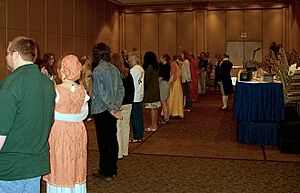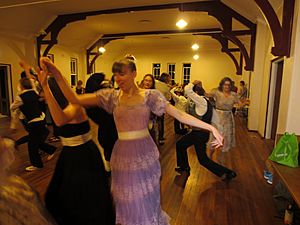Regency dance facts for kids
Regency dance refers to the historical dances popular from about 1790 to 1825. While the actual "Regency" period in England was shorter (1811-1820), the term is often used for this wider time. This is because the style of art, fashion, and dance stayed similar throughout these years.
Many people learn about this dance era from Jane Austen's novels. Her books often feature balls and dances. However, movies based on her stories sometimes show modern versions of English Country Dance. These movies often don't show the correct steps or social style of the time. Real Regency dances were lively and bouncy. Dancers used steps from simple skipping to fancy ballet-like moves.
Contents
Popular Dances of the Early Regency (1790s-1810s)
In the early part of this period, up to the early 1810s, three main types of dances were popular: the country dance, the cotillion, and the scotch reel.
Country Dance: Dancing in Lines
The longways Country Dance involved a line of couples. They would perform different patterns with each other. Dancers moved up and down the line. Often, these dances began with couples marching briefly. Then, the first lady and her partner would dance down the line. Each couple would take a turn dancing down the line when they reached the top. This could take a long time, sometimes an hour for a long line of dancers.
An important part of the country dance was the "calling." The leading lady would call out the dance figures, steps, and music. This was a position of honor. Other dancers would listen to the caller or watch the leading couple to learn the dance. Jane Austen herself mentioned calling dances with her partner in her letters.
Cotillion: French Square Dances
The cotillion came from France. It was danced in a square formation and used more complex footwork. Each cotillion had a special "chorus" figure. This chorus was danced in between a standard series of up to ten "changes." Changes were simple moves, like a right-hand star, that were common to all cotillions.
Scotch Reel: Lively Group Dances
The scotch reel of this time involved three or four dancers in a line. They would alternate between "heying" (interlacing arms) and "setting" (fancy steps danced in place). More complicated reels are described in old dance books. However, it's not clear if these became truly popular. Some descriptions from the 1820s mention a six-person reel. There are also dance notes showing eight-person reels, danced in squares like cotillions.
New Dances of the Later Regency (1810s)
In the 1810s, during the actual Regency period, English dance began to change. Two new dances became very popular: the quadrille and the waltz.
Waltz: A Daring New Dance
The Waltz first arrived in England around 1810. At first, many people thought it was too daring. It wasn't fully accepted until visitors from other countries danced it in London after the Napoleonic Wars. Even then, some people wrote angry articles and made jokes about it. Even Lord Byron, a famous poet, was shocked by how close people danced. The Regency waltz was slower than later versions. Dancers stayed on the balls of their feet and held their arms in graceful ways. The Sauteuse was a leaping waltz. It was often danced to 2/4 music instead of 3/4. It had a leap-glide-close pattern.
Quadrille: Shorter Square Dances
The Quadrille was brought to England from France in 1815 by Lady Jersey. It was a shorter version of the earlier cotillions. Instead of many "changes," the quadrille used a set of five or six figures from different cotillions. This made the dances much shorter. By the late 1810s, it was common to dance several quadrilles in an evening. They usually had the same first three figures, but different fourth and fifth figures. Jane Austen's niece, Fanny, danced quadrilles. Jane herself wrote that she thought they were not as good as the cotillions she danced when she was young.
By the late 1810s, the quadrille was very popular. Dance teachers started creating "new" country dances. They often borrowed moves from the quadrille. They gave these dances fancy names like "Danse Ecossoise" (Scottish Dance) or "Danse Espagnuole" (Spanish Dance). These names made them sound like completely new dances. In reality, they were just small changes to the classic country dance. A few of these dances became so popular that they lasted through the entire 19th century. For example, the "Spanish dance" is still popular today in vintage dance groups. It is one of the few survivors of its kind from the Regency era.
Other Notable Dances
"La Boulangere" is a simple circle dance for couples. It is the only dance mentioned by name in Jane Austen's writings. Sir Roger de Coverly, mentioned by Charles Dickens, is the dance that later became America's Virginia Reel.
Many instruction manuals from the Regency era still exist. Several by Thomas Wilson are available online from the US Library of Congress. The Scotch Reel is described by Francis Peacock. His manual is also in the Library of Congress collection.
Regency Dance Today: A Revival
The first big revival of English Country Dance, a main type of Regency dance, happened in the early 1900s. This was thanks to an Englishman named Cecil Sharp. Many other revivals have happened since then. Most of them use some of Sharp's original research. Today, groups around the world perform many types of English period dances. This includes many dances popular during the English Regency.
Regency dance has also become popular at science fiction conventions. This is partly due to the efforts of John Hertz. Reconstructed dances from the Regency era are taught to both new and experienced dancers. Some authors, like Larry Niven, have also shared their excitement for this trend.
In Silicon Valley, the Bay Area English Regency Society offers dance classes and formal balls. These events take place in churches, community centers, and other places. In Los Angeles, California, the Valley Area English Regency Society hosts teas and Regency dance parties. Both societies were started by Laura Brodian Freas Beraha.
Some fans take their love for Regency dance very far. Cisco Systems founders Sandra Lerner and Len Bosack created a foundation. This foundation bought a Regency-era country house that once belonged to Jane Austen's brother. In Australia, the Earthly Delights Historic Dance Academy and John Gardiner-Garden run a Regency Dance School. This school is part of the Jane Austen Festival Australia every April.




